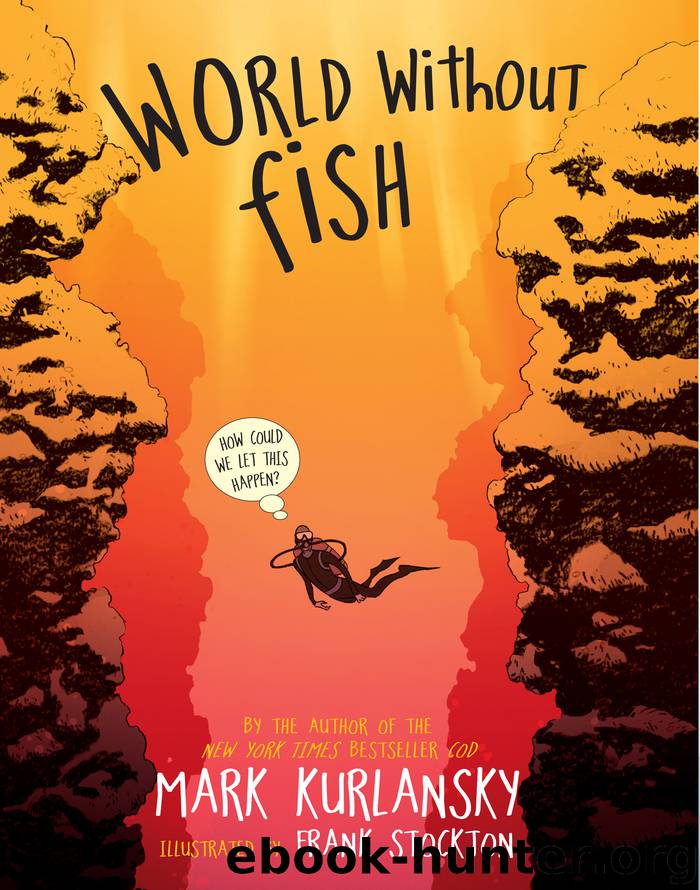World Without Fish by Mark Kurlansky

Author:Mark Kurlansky
Language: eng
Format: epub
Publisher: Workman Publishing Company
Published: 2011-10-23T16:00:00+00:00
auroch
(Bos primigenius)
An ancestor of domestic cattle, aurochs inhabited Europe, Asia, and North Africa until they became extinct in 1627.
The fact that farmed fish are considerably different from their wild ancestors is immediately apparent. Because they live in overcrowded pens and swim much less than their wild cousins, the muscle tissue of farmed fish have a different consistency. Some species don’t even look like their wild ancestors anymore. A farmed striped bass resembles a wild one only in the black and silver stripes for which it was named. The farmed striped bass are much smaller and have an entirely different shape to their pointy heads and short bodies.
But a greater problem in farm fishing is that farmed fish lose their survival skills. A fish pen does not have the survival struggle of the wild. There are no predators there and fish are largely protected from storms and temperature changes.
put back into the wild, a farmed fish would probably not know how to survive.
If a farmed fish mated with a wild fish, their offspring might also lack these survival skills. A salmon might not know to return up the river of its birth for spawning. A cod might lack the enzyme that it needs to release to keep from freezing in subarctic water. Even just a few farm fish accidentally released into the wild could menace the survival of an entire wild population.
Furthermore, overcrowded pens produce such enormous quantities of waste—including chemicals that are sometimes used—that they pollute surrounding waters. While the fish-farming industry is well aware of these problems and is trying to address them with such ideas as vegetable alternatives to feed, such measures will take the farmed species even further away from the wild species and make them even more dangerous for the evolution of the species.
It should also be remembered that while the problem is preserving fish, fish farming does nothing to preserve fisheries.
So if fish farming isn’t a good solution, what about limiting the fish that fishermen are allowed to catch?
It seems obvious that if the problem is that fishermen are catching too many fish, the solution should be to tell them to catch less. That has been done. But it is not a simple solution.
fishermen cannot be told simply to catch fewer fish. a system of rules has to be established that can be enforced with penalties
for those found catching more than they are allowed. The number must be established for each species in each fishing area and it has to change regularly because fish populations change. What is the total population in the area for each species? Since the fish cannot be seen and they move around, they are difficult to count. Scientists test small parts of the ocean by fishing with nets and then using a computer to estimate the total population based on that catch. But they make mistakes. Sometimes they allow too many fish to be caught because they thought the population was bigger than it actually was. Iceland, after successfully estimating
Download
This site does not store any files on its server. We only index and link to content provided by other sites. Please contact the content providers to delete copyright contents if any and email us, we'll remove relevant links or contents immediately.
The Giant and How He Humbugged America by Jim Murphy(3334)
The Science Book (Big Ideas Simply Explained) by DK(3177)
Harry Potter: A History of Magic by British Library(2978)
The Elements by Theodore Gray(2954)
A Short History of Nearly Everything by Bryson Bill(2578)
Make by Mike Westerfield(2255)
Easy Electronics by Charles Platt(2252)
The Astronomy Book by DK(2085)
The Cat in the Hat by Dr. Seuss(2080)
CLICK'D by Tamara Ireland Stone(1800)
Science Experiments You Can Eat by Vicki Cobb(1795)
Calling All Minds by Temple Grandin(1750)
The Crime Book (Big Ideas Simply Explained) by DK(1734)
03 The Prophet of Yonwood by Jeanne DuPrau(1732)
Think Like a Rocket Scientist by Ozan Varol(1725)
Pax by Sara Pennypacker(1693)
Minecraft by Mojang Ab(1691)
Martin Gardner's Science Magic by Martin Gardner(1658)
Getting Started with Soldering: A Hands-On Guide to Making Electrical and Mechanical Connections by Vinck Marc de(1610)
